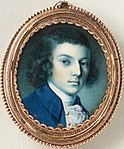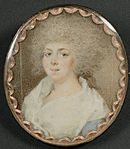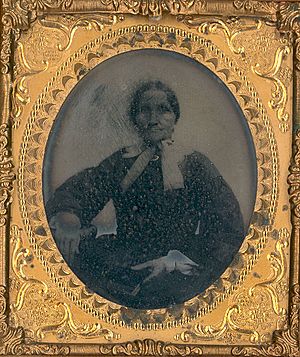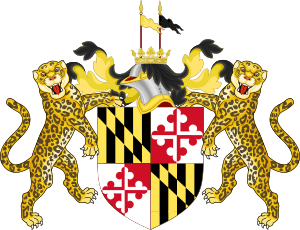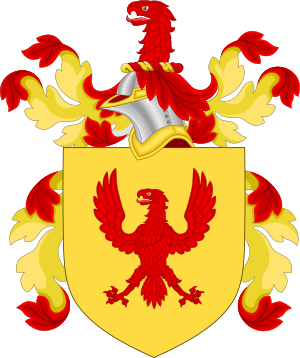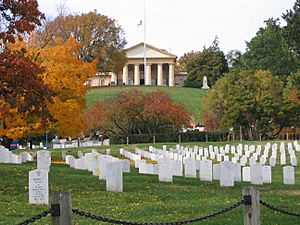George Washington Parke Custis facts for kids
Quick facts for kids
George Washington Parke Custis
|
|
|---|---|
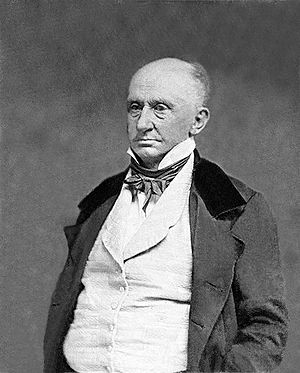
Undated daguerreotype of Custis
|
|
| Born | April 30, 1781 Rosaryville, Maryland, U.S.
|
| Died | October 10, 1857 (aged 76) |
| Resting place | Arlington National Cemetery |
| Education |
|
| Occupation | Author |
| Spouse(s) |
Mary Lee Fitzhugh
(m. 1804) |
| Children | 5 or 6 |
| Parent(s) |
|
| Relatives |
|
George Washington Parke Custis (born April 30, 1781 – died October 10, 1857) was an American plantation owner, writer, and playwright. He was the step-grandson of George Washington. George and his sister Eleanor grew up at Mount Vernon with George and Martha Washington.
When he turned 21, Custis inherited a large fortune from his father. This included a plantation in what is now Arlington County, Virginia. He built a grand house called Arlington House (1803–1818) there. It was designed to honor George Washington. Custis kept many of Washington's belongings on display at Arlington House. He also wrote plays about Virginia and published a book about George Washington after his death.
His daughter, Mary Anna Randolph Custis, married Robert E. Lee. They inherited Arlington House. However, the United States government took the property during the Civil War. After the war, the Supreme Court ruled that the property was taken illegally. It was returned to Lee's family. They then sold it back to the government. Today, Arlington House is a museum. Fort Myer and Arlington National Cemetery are also on land that was once part of Custis's plantation.
Contents
Early Life and Education
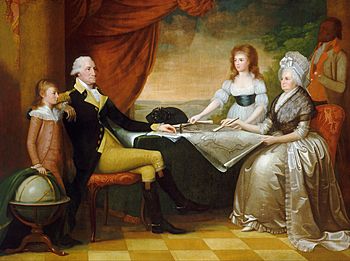
"The Washington Family" by Edward Savage, painted between 1789 and 1796. It shows (from left to right): George Washington Parke Custis, George Washington, Nelly Custis, Martha Washington, and an enslaved servant.
George Washington Parke Custis was born on April 30, 1781. His birthplace was his mother's family home in Rosaryville State Park, Maryland. He lived with his parents, John Parke Custis and Eleanor Calvert Custis, and his three older sisters. They lived at Abingdon Plantation in Virginia.
Six months after George was born, his father died. His father was the stepson of George Washington. George's grandmother, Martha Washington, had married George Washington in 1759. After his father's death, George and his sister Nelly went to live with the Washingtons. They grew up at Mount Vernon and were treated like adopted grandchildren. His two older sisters stayed with their mother.
In 1789, George and Nelly moved to New York City with the Washingtons. New York was the first capital of the United States. Later, they moved to Philadelphia when it became the capital.
Custis, nicknamed "Washy," went to several schools. These included the Philadelphia Academy, Princeton University, and St. John's College. George Washington often felt frustrated with young Custis. He worried about Custis's attitude and studies.
Building Arlington House
When Custis turned 21 in 1802, he inherited a lot of money, land, and property. This came from his father and his grandfather. When Martha Washington died in 1802, Custis also received money and land from her. He moved to land inherited from his father.
Almost right away, Custis started building Arlington House. This land was in what is now Arlington County, Virginia. He hired George Hadfield as the architect. The mansion was the first example of Greek Revival architecture in America. Custis chose a high hill for the house. It overlooked the Potomac River and the growing city of Washington.
Custis used enslaved labor and materials found on his land to build the house. Construction was paused during the War of 1812. The British burned Washington, D.C., causing material shortages. The outside of the mansion was finished in 1818. Custis wanted Arlington House to be a living memorial to George Washington. He included designs similar to Mount Vernon. He became known for hosting many parties and events at the mansion. He displayed many items from Mount Vernon there.
Marriage and Family
On July 7, 1804, Custis married Mary Lee Fitzhugh. They had four children, but only one daughter lived to adulthood. Her name was Mary Anna Randolph Custis. She married Robert E. Lee at Arlington House on June 30, 1831.
Military Service
In 1799, Custis joined the United States Army. He became a second lieutenant. He served as an assistant to General Charles Cotesworth Pinckney. He left the army in 1800.
During the War of 1812, Custis helped defend Washington, D.C. He helped fire an artillery piece during the Battle of Bladensburg. He also spoke out against the killing of a Revolutionary War general.
Slavery and Freedom
George Washington Parke Custis owned enslaved people on his lands in Virginia. In 1820, he owned 116 enslaved people in one county and 58 in another. By 1850, he owned 98 enslaved people in New Kent County and 34 in King William County.
In the 1820s, Custis was part of the American Colonization Society. This group supported sending free African Americans to Africa, especially to Liberia. However, most enslaved people did not want to go to Africa. Only one family from Arlington House chose to move to Liberia.
In 1826, Custis acknowledged he was the father of Maria Carter. Maria was born in 1803 to an enslaved maid named Arianna "Airy" Carter. Maria lived and worked at Arlington House as an enslaved person. In 1826, she married Charles Syphax, who oversaw the dining room at Arlington House. Soon after her marriage, Custis freed Maria. He gave her a 17-acre (6.9 ha) plot of land on the Arlington estate. Maria raised ten children on this land.
Social Life and Public Service
In 1802, Custis helped the Washington Jockey Club find a new horse racing track. He supported moving the races to Meridian Hill.
In 1815, Custis became a member of the American Antiquarian Society. This group studies and preserves American history.
In 1836, Custis built a mill on Four Mile Run in Virginia. It ground grain for local farmers. This site later became important during the Civil War.
In 1846, the part of Washington, D.C., that was south and west of the Potomac River was returned to Virginia. This area included Alexandria. Custis first opposed this change, but later supported it.
On July 4, 1848, Custis attended the ceremony for the Washington Monument cornerstone. He was there with President James K. Polk. On July 4, 1850, Custis dedicated a stone for the Monument. President Zachary Taylor also attended this ceremony.
Writings and Plays
Custis was known as a speaker and a playwright. He gave a speech about Russian victories in 1813. Two of his plays were published during his lifetime. These were The Indian Prophecy; or Visions of Glory (1827) and Pocahontas; or, The Settlers of Virginia (1830). He wrote other plays too, like The Rail Road (1828).
After his death in 1857, his writings about George Washington were published. The book was called Recollections and Private Memoirs of Washington (1860).
Family Connections
Custis came from important families from the colonial era. His mother, Eleanor Calvert Custis Stuart, was related to British nobility.
Custis's sister, Eleanor "Nelly" Parke Custis Lewis, married George Washington's nephew, Lawrence Lewis. As a wedding gift, Washington gave Nelly land from Mount Vernon. The Lewises built Woodlawn plantation there.
Another sister, Martha Parke Custis Peter, married Thomas Peter. They used Martha's inheritance from George and Martha Washington to buy land in Georgetown. They built the Tudor Place mansion there. Tudor Place looks similar to Arlington House and Woodlawn.
Death and Legacy
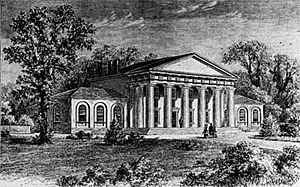

Custis died on October 10, 1857. He was buried at his Arlington estate next to his wife, Mary Lee Fitzhugh Custis. She had died four years earlier.
Custis's will stated that:
- Arlington plantation (about 1100 acres) and its contents would go to his only surviving daughter, Mary Anna Randolph Custis. After her death, it would go to his grandson, George Washington Custis Lee.
- His other two grandsons would receive other plantations.
- His enslaved people, about 200 of them, were to be freed. This had to happen no later than five years after his death.
Custis's death affected the careers of Robert E. Lee and his sons. Robert E. Lee was named the will's executor. He took a two-year break from the army to manage the estate. During this time, he led troops to stop John Brown's raid on Harpers Ferry.
At the start of the American Civil War, the Union Army took the Arlington Plantation. They needed it for military reasons. The U.S. government then took the Custis estate because taxes were not paid. In 1863, a "Freedman's Village" was created there for formerly enslaved people.
On December 29, 1862, Robert E. Lee freed all the remaining enslaved people from the Custis estate. This was the last day allowed by the will.
In 1864, parts of Arlington Plantation were used as a military burial ground. After the Civil War, George Washington Custis Lee sued the government. He won back the title to Arlington Plantation in 1882. The Supreme Court of the United States ruled in his favor. Lee then sold the property back to the U.S. government for $150,000.
Arlington House, which Custis built to honor George Washington, is now the Robert E. Lee Memorial. It is a museum open to the public. Fort Myer and Arlington National Cemetery are also on land that was once part of the Arlington Plantation.
See also
- Samuel Osgood House – First Presidential Mansion.
- Alexander Macomb House – Second Presidential Mansion.
- President's House (Philadelphia) – Third Presidential Mansion.
- Germantown White House – Fourth Presidential Mansion (oldest surviving presidential residence).


